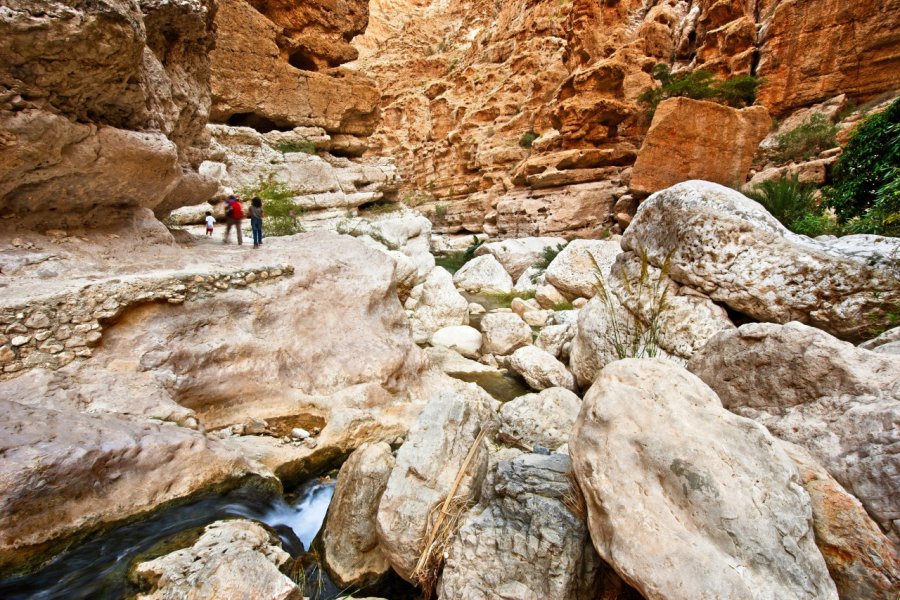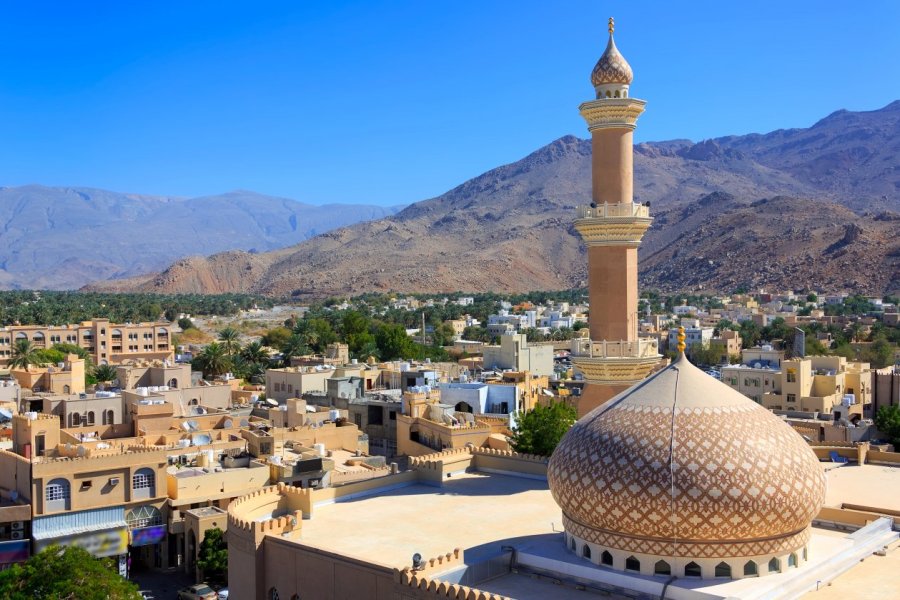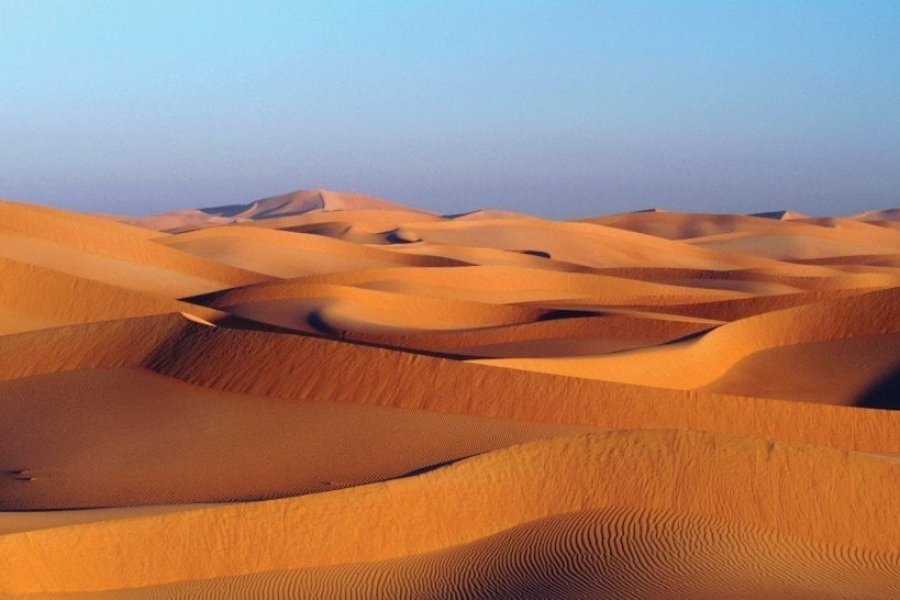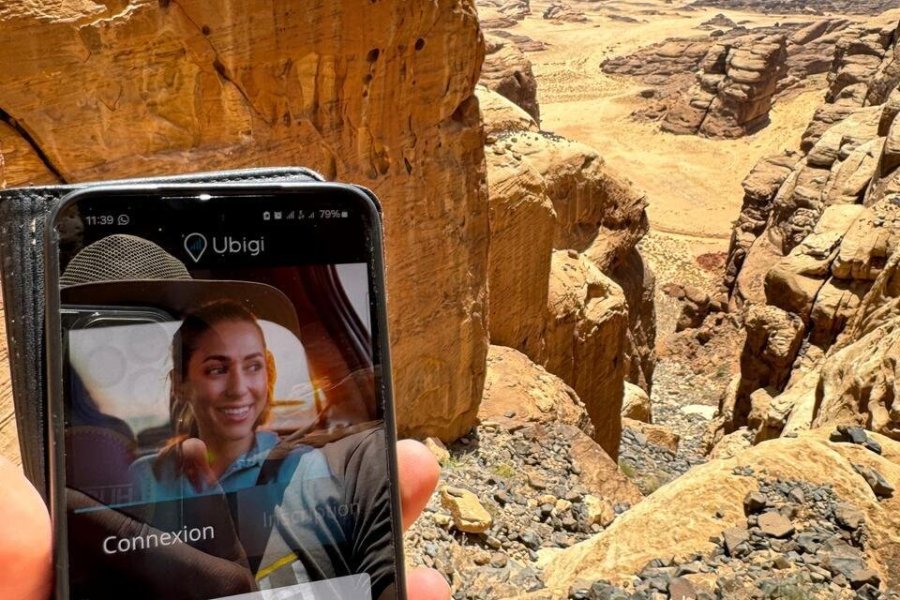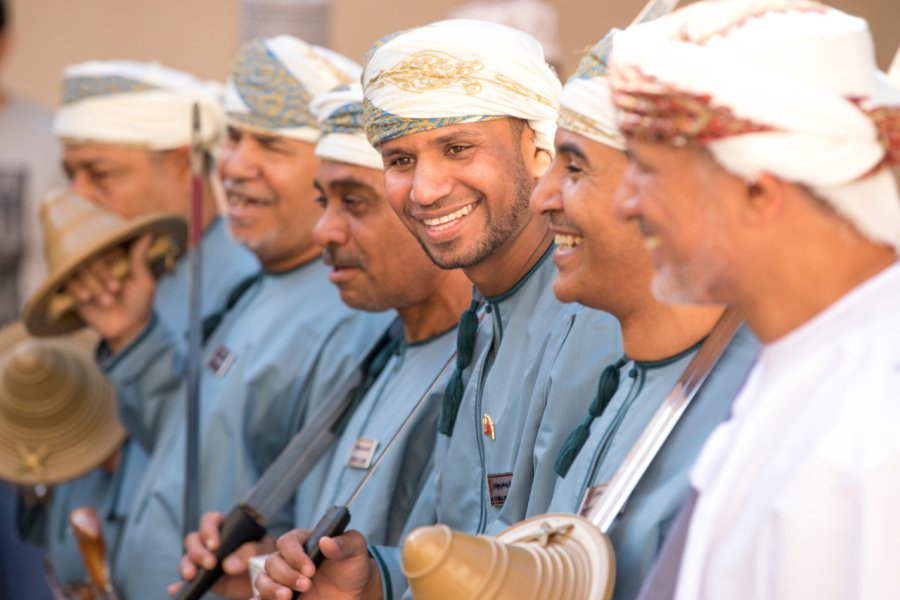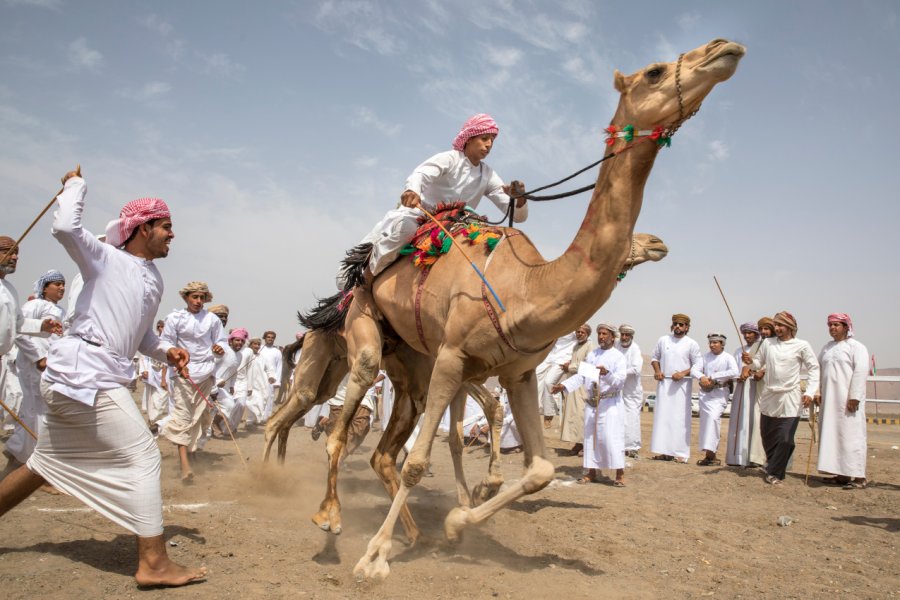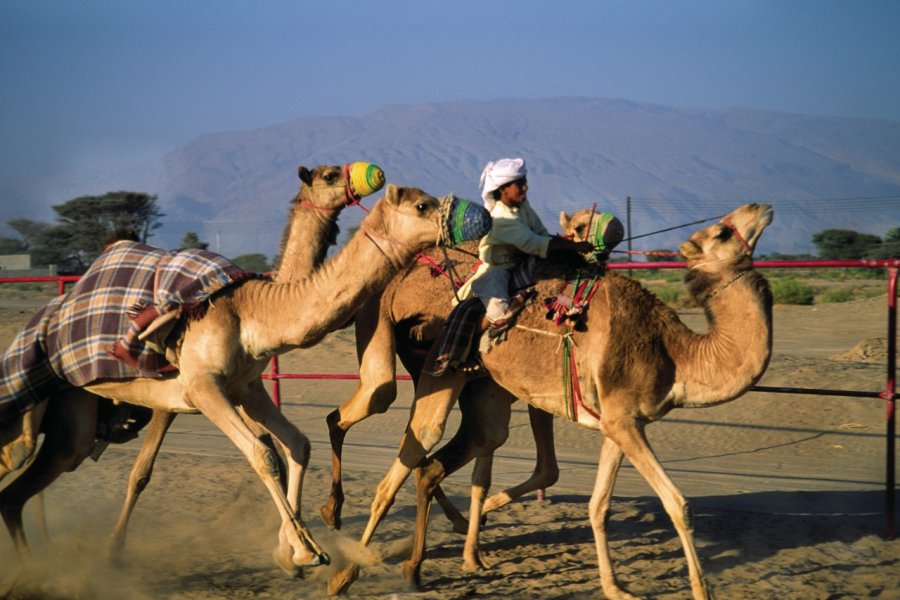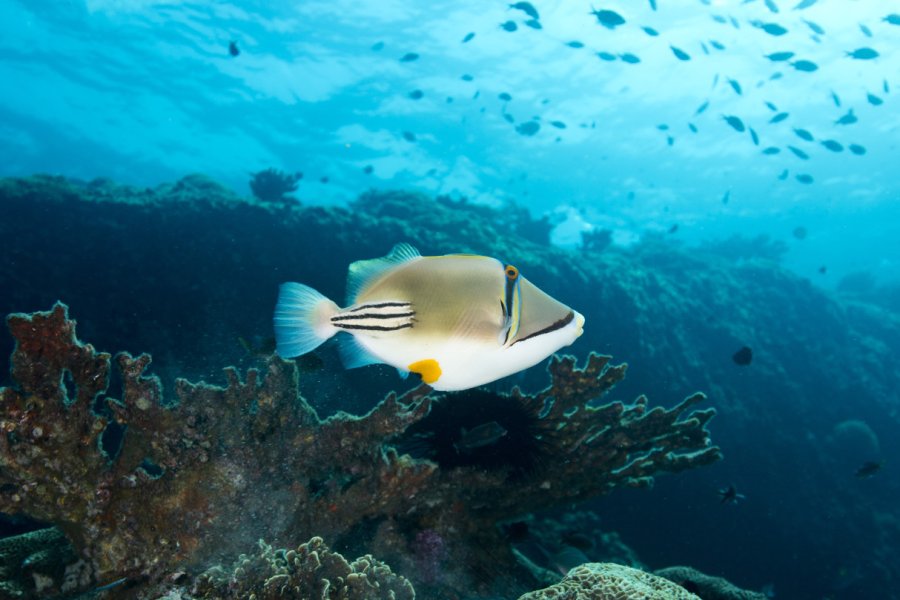Travel guide Oman
Between Yemen and the United Arab Emirates, south of Saudi Arabia and opposite Bombay, this great sultanate open to the Indian Ocean is a jewel, offering magnificent landscapes, rich biodiversity and a few architectural gems. Discover all the points of interest not to be missed! Oman is known as the Switzerland of the Arabian Peninsula. Oman alternates between the fjords of the Musandam peninsula, wadis with lush palm groves, spectacular mountains including the magnificent Wadi Ghul canyon (3,000 m), a desert punctuated by djebels and colorful dunes, and miles of coastline. Preserved from the excesses of modernity, this Sultanate with its thousand-year-old history, Arabic language and Ibadite Muslim religion, evokes Sinbad the sailor, the Queen of Sheba and the Arabian Nights. The desert is still inhabited by Bedouins with their caravanning traditions. Oman, then, is both the kingdom of camel racing and a land of birdwatching and turtle-laying sites.
Muscat, the port capital, also has its treasures: an opera house, a formidable national museum with modern scenography, the Baït al-Zubair Museum of Popular Arts and Traditions, the al-Alam royal palace of the late sultan Qabus ibn Saïd and the Grand Mosque of the same sultan, a sumptuous contemporary edifice designed for 20,000 worshippers. To the west of Muscat, the old port of Matrah is a must-see for its lively souk and fish market. Enjoy the scent of Omani incense, reputed to be among the best in the world, made from resin from the Dhofar mountains. Your tour guide will reveal many more of Oman's secrets, including the best restaurants and most unusual accommodations.
What to see, what to do Oman?
-
Book an activity
-
Customized travel
- The most beautiful cities Oman
When to go Oman ?
The best time to visit northern and central Oman is winter, between November and March, when temperatures are mild (around 25°C during the day). But the months of October and April are also very pleasant and more favorable for swimming in the sea, which is then warmer. In fact, it's during these two months that divers will find optimal visibility. The south of the country can be visited all year round, but to fully appreciate the beauty of the Dhofar region, the best time to visit is in summer, from June to September, during the monsoon season (kareef). The vegetation is then extremely lush and the climate very pleasant. Muscat's inhabitants generally come here to escape the heat of the capital. Since 1995, a festival has been held in Salalah in August.
Suggested addresses Oman
Travel Oman
-
Find a hotel
-
Car Rental
-
International e-SIM package
-
Find a local agency
Several themes are available to anyone who wants to visit the Sultanate. It all depends on the length of stay, the interests of each person and the budget. In the short version, one can opt for a long weekend in Muscat - beach and culture, modernity and traditions. In the longer mode, 2 or 3 days in the capital can be followed by a break in another part of the sultanate (mountains, desert...). Unless you opt for the most classic circuit, which, in about 1,000 km, leaves Muscat, passes through the mountains, the desert, the wadis, to return by the coast and the turtle coast - a circuit to be punctuated with cultural incursions (aflaj, forts, museums...) and/or sports activities (trekking, canyoning, mountain biking...). 3 more days, and here is the great tropical south or the fjords of Musandam in the north. The adventurers, them, will find in this still recent destination a huge playground where they can quench their thirst for discovery.
Find unique Stay Offers with our Partners
How to go Oman
How to go alone
Going it alone is the best way to get away cheaply. Flights connect Muscat with European capitals. If you rent a car, the chauffeur-driven option will save you a lot of trouble and fright, especially in the desert. No problem on the main roads. Use a local agency to organize a particular excursion. If you don't speak Arabic, English will help you - it's widely spoken. And don't criticize the sultan, whose power is absolute.
How to go on a tour
Oman is a tourist destination with the wind in its sails! Around a hundred tour operators offer stays and tours in Oman, from 3 days to 8 days, often without international flights. Package tours to Oman are a fairly costly option, even when reduced to a simple seaside holiday. Some more original formulas include 4x4 rental or a combination with Dubai.
How to get around
Oman Air operates two domestic routes: Muscat/Salalah and Muscat/Khasab (1h40 flight). The national bus company provides low-cost services to major cities. There are also shared cabs. Renting a car is a good option (good roads, cheap petrol). An off-road vehicle is preferable, if not essential, depending on your itinerary. In town, you can use cabs. There are also connections between Muscat and Musandam on the world's two fastest ferries.
Featured articles Oman
Discover Oman
Welcome to the plural Orient: that of a great civilization of sailors and conquerors, and of a country at the crossroads of the great historical trade routes - which once traded incense with the most prestigious nations and today trades gas and black gold with other powers. It's a land of rock, sand and water, steeped in cross-fertilization and passage, with a rich, tormented past and preserved folklore and traditions. It's an encounter with a people, wise and peaceful: their religion, their values, their different heritages - architectural, musical, culinary. Immerse yourself in a diverse and protected natural environment, where environmental issues are a priority, and travel from biotope to biotope, magnetized by so many untouched spaces - deserts, mountains, wadis, fjords, beaches..
It's a fascinating discovery of a country in the throes of change: drawn by its future, held back by its past.
Pictures and images Oman
The 12 keywords Oman
1. Lovemaking
In 1983, Sultan Qaboos decided to call upon a French nose, Guy Robert, to create a line of luxurious fragrances. By mixing more than 120 ingredients, including frankincense and rose, Gold, the first fragrance of the Amouage brand, was born. To this day, it is one of the most expensive fragrances in the world. It is handcrafted.
2. Boat or dhow

A symbol of Omani power, this traditional wooden sailing ship is the pride of the Sultanate. Partially replaced by motor cargo ships, dhows are still omnipresent in Oman where they are used for fishing, pleasure boating and merchant transport. The city of Sur, in the west, perpetuates its centuries-old building tradition.
3. Coffee with cardamom

Quite simply THE national drink: a black coffee with a unique taste, without sugar, flavoured with cardamom and served with dates to reduce the bitterness. Symbol of hospitality, kawa is offered at every meeting and is tasted in tiny cups, everywhere, all the time, at home or in tourist places.
4. Dates
Fruit that you give with the cardamom coffee as a sign of welcome. Product of the date palm, an omnipresent tree in Oman, whose cultivation gives rhythm to the life of many Bedouin tribes. The sultanate would count several dozen different varieties especially harvested in the hot months. A single palm tree could produce up to 100 kg of dates.
5. Deserts and mountains
More than two thirds of the country is occupied by desert: the sands of Sharqiyah in the east, the arid stretches of the Rub Al Khali on the borders of Saudi Arabia and Yemen. Elsewhere, mountains take over, culminating up to 3,020 metres for the highest of them all, the Jebel al-Akhdar, in the Hajar massif, the backbone of the country.
6. Dromedaries

And not camels because they only have one hump! Omnipresent and intimately linked to the local traditional culture, they roam almost freely, roaming the desert in search of greenery. There are pack camels for domestic use, riding or racing camels whose value can exceed that of the best purebred Arabian horses.
7. Incense
Aromatic gum that is extracted by making an incision in a Boswellia type tree. It is to its trade that the country owed its prosperity well before the Christian era. The Boswellia sacra tree grows in Dhofar and produces the purest incense in the world or hojari, a particularity that has enabled the country to be classified as a UNESCO World Heritage Site.
8. Falaj (aflaj)
An ancestral irrigation system consisting of capturing a source of water and transporting it through underground galleries or a surface canal to villages (ablution, toilet, household use) and plantations. Present throughout the territory and representative of the traditional sultanate, the aflaj network is classified as a UNESCO World Heritage Site.
9. Forts and castles
The sultanate would count more than 500 of them, majestic witnesses of a bellicose past. If the forts and citadels were intended for a warlike and protective use, the castles were mainly used as residences and administrative centres. Nowadays, these jewels of heritage are the subject of a vast safeguard plan and are renovated for tourism.
10. Halwa
A national and traditional Omani dessert made of rose water, brown sugar, flour, sesame seeds and spices that are cooked for hours in a large copper pot. Popular with locals and flavoured in many different ways depending on the region (cardamom, saffron, walnuts, almonds...), halwa is eaten cold, usually with coffee.
11. Kandjar

It is the country's emblem: a dagger with a curved blade that Omanis wear on special occasions or official ceremonies. Sculpted in silver, wood or horn, it fits into a belt that tightens the dishdasha (traditional tunic) at the waist. An essential accessory of the costume, it denotes the social status of the wearer.
12. Kumma
The kumma is the traditional hat worn by the men of the sultanate. It is a small round cotton hat, embroidered with various motifs (especially floral) and stitched with small holes for ventilation. The kummas come in a variety of colours to match the tones of the dishdashas. Young people wear it in many different ways, flattened, pinched or swollen.
You are from here, if...
You speak calmly and always remain calm and courteous. You do not show any form of affection in public and remain moderate in what you say and how you look.
You wear long, covering clothes that respect the local culture and religion. They are always clean and impeccably ironed. You look as unkempt as possible.
You leave in two cars in the desert and check that no thunderstorms are expected before entering a wadi. You love nature and outdoor life.
You drink cardamom coffee with dates to reduce the bitterness. You hold your cup in your right hand and shake it slightly, tilting it from right to left to indicate to your host that you do not wish to be served again.
You take off your shoes when entering a mosque of course, but also in a house so as not to walk on the carpets with your shoes on.

